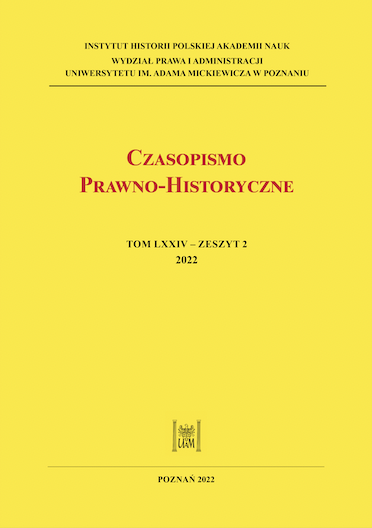Karnoprawna ochrona symboli państwowych w okresie II Rzeczypospolitej
CRIMINAL LAW PROTECTION OF STATE SYMBOLS DURING THE SECOND REPUBLIC OF POLAND
Author(s): Olga ByndiuSubject(s): Law, Constitution, Jurisprudence, History of Law, Criminal Law
Published by: Uniwersytet Adama Mickiewicza
Keywords: protection of state symbols; legal doctrine concerning state symbols; criminal law; judicial decisions of the Supreme Court; destruction; removal; insult to state symbols
Summary/Abstract: The Polish state symbols are an important element of statehood, which is why they have always required proper legal protection. More than one hundred years of history of the functioning of this legal regulation brings about an analysis of this huge legacy as well as the exploration of the vast legal output, which was accumulated in the past periods of history. For this purpose, an analysis of legal acts, judicial decisions of (primarily) the Supreme Court, and the doctrine from 1918 to 1939 was undertaken. The first part grants the opportunity to get acquainted with the legal regulation concerning the protection of state symbols from the establishment of the new Polish state until the beginning of the Second World War. This part delineates the criminal codes of the former partitioning states of Germany and Russia, which were in force in the Republic of Poland on a provisional basis until the adoption of the state’s own code in 1932. Subsequently, the Act of 1 August 1919 on the Coat of Arms and the Colours of the Republic of Poland and the Decree of the President of the Republic of Poland of 13 December 1927 on the Coat of Arms and the Colours of the State as well as on the Insignia, Banners, and Seals were analyzed. Then the codification process of the future first Criminal Code of Poland as well as the legal regulation concerning state symbols (finally adopted in 1932) are presented in considerable detail. The analysis is further complemented by quoting the contemporary judicial decisions of the Supreme Court, which in many cases contained an interpretation of the legal regulation concerning the aforementioned subject matter. The image is complemented by a legal doctrine, including opinions of eminent lawyers, practitioners, and commentators of the period as well as authors of the code such as J. Makarewicz, W. Makowski, A. Mogilnicki, E. Rappaport, et al.
Journal: Czasopismo Prawno-Historyczne
- Issue Year: 74/2022
- Issue No: 2
- Page Range: 155-178
- Page Count: 24
- Language: Polish

